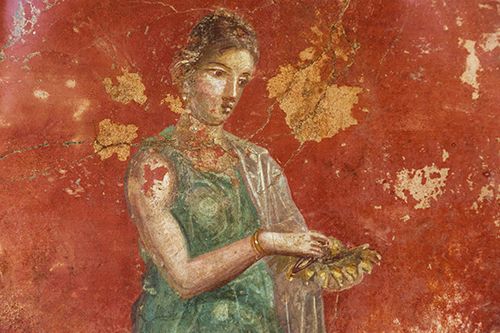Investigating Coeliac Disease in Roman Remains
Using GC–MS and light microscopy, researchers have investigated the dental calculus of a roman woman with coeliac disease and found she came into contact with gluten-rich cereals that would have been deleterious to her, and would likely have contributed to her premature death.
jefwod/Adobe Stock

Gluten has been part of the human diet for centuries, and as such it would be useful to discover if earlier civilizations experienced diseases related to gluten consumption, such as coeliac disease (CD), and how these civilizations attempted to treat such ailments.
The use of medicinal and aromatic plants was a common form of treatment historically, with various texts citing knowledge of natural remedies featuring plants, seeds, flowers, fruits, and other ingredients that have useful bioactive compounds. This tradition continues in many cultures, including China, and in some cases is passed on as common knowledge through generations. However, gleaning any firstâhand information on applied remedies to ancient remains can prove difficult.
Interestingly, the skeletal remains of a Roman woman from the late first century to early second century common era (CE) displayed pathological signs evocative of coeliac disease. The skeleton of a 18–20-year-old female discovered at an archaeological site in Cosa, in Tuscany, Italy, was diagnosed with osteoporosis, osteopenia, coxa valga, dental enamel hypoplasia, and cribra orbitalia. These are all pathologies attributed to CD because of the associated difficulties of nutrient adsorption (1,2). Further molecular analyses showed that the young woman presented the HLA-DQ 2.7 halotype, which is typically associated to a high predisposition for CD (2,3).
There have been no other archaeological findings related to CD, so these remains presented a unique opportunity to reconstruct food habits and attempted therapeutic treatments.
Using gas chromatography–mass spectrometry (GC–MS) and light microscopy, researchers were able to investigate the dental calculus of the individual (4). Light microscopy provided evidence that she came into contact with gluten-rich cereals that would have been deleterious to a CD sufferer, and would likely have contributed to her premature death. GC–MS analysis revealed she was ingesting plant foods and herbs, with two notable markers for Curcuma sp. and Panax sp. being detected. These plant stems (rhizomes) were commonly used in ancient Oriental medicine, perhaps suggesting cultural contact and exchange with eastern Asia. Researchers hypothesized that the woman was using these roots as a natural remedy in an attempt to soothe her pathological condition because these roots were considered to possess energizing properties as well as antiâinflammatory and immunomodulatory properties.
This research suggests that diseases such as CD have existed throughout human civilization and their unfortunate sufferers were unaware of the cause. Aretaeus of Cappadocia, a celebrated Greek physician from the second century before the common era (BCE), used the Greek word “koiliakos”, which means “suffering in their abdomen” to describe a chronic wasting illness associated with diarrhoea, a main symptom of CD (4).
References
- G. Gasbarrini et al., J. Clin. Gastroenterol44, 502–503 (2010).
- G. Gasbarrini et al., World J. Gastroenterol 18, 5300 (2012).
- D.N. Amarapurkar et al., Trop. Gastroenterol36, 174–178 (2016).
- A. Gismondi et al., Archaeol. Anthropol. Sci. 12, 6 (2020).
Best of the Week: Food Analysis, Chemical Migration in Plastic Bottles, STEM Researcher of the Year
December 20th 2024Top articles published this week include the launch of our “From Lab to Table” content series, a Q&A interview about using liquid chromatography–high-resolution mass spectrometry (LC–HRMS) to assess chemical hazards in plastic bottles, and a piece recognizing Brett Paull for being named Tasmanian STEM Researcher of the Year.
Using LC-MS/MS to Measure Testosterone in Dried Blood Spots
December 19th 2024Testosterone measurements are typically performed using serum or plasma, but this presents several logistical challenges, especially for sample collection, storage, and transport. In a recently published article, Yehudah Gruenstein of the University of Miami explored key insights gained from dried blood spot assay validation for testosterone measurement.
Determination of Pharmaceuticals by Capillary HPLC-MS/MS (Dec 2024)
December 19th 2024This application note demonstrates the use of a compact portable capillary liquid chromatograph, the Axcend Focus LC, coupled to an Agilent Ultivo triple quadrupole mass spectrometer for quantitative analysis of pharmaceutical drugs in model aqueous samples.